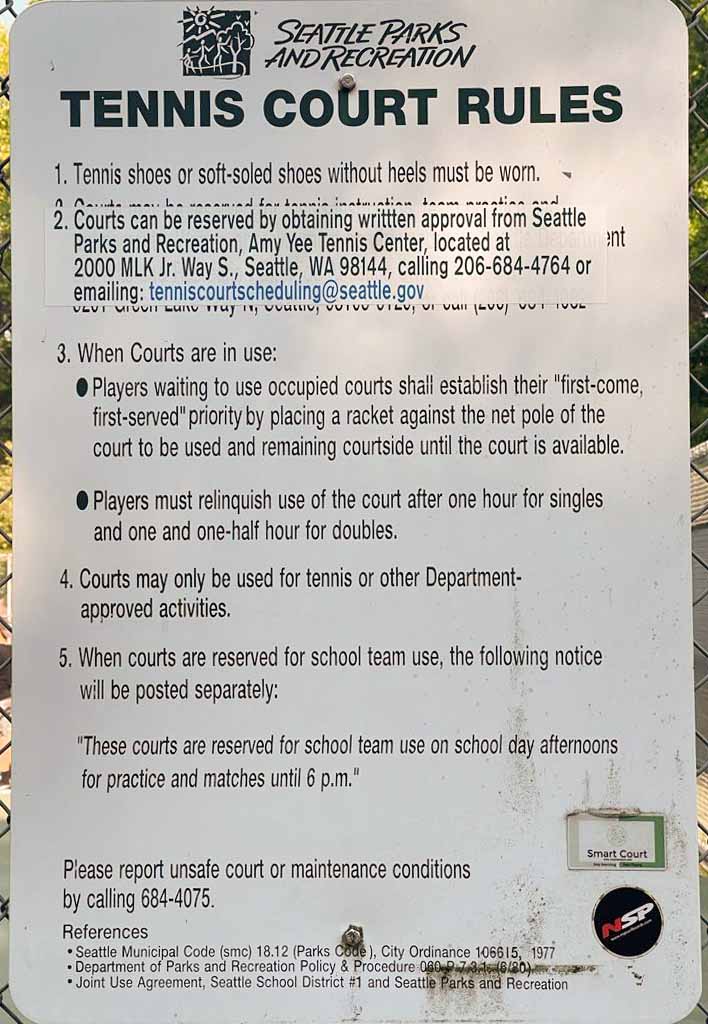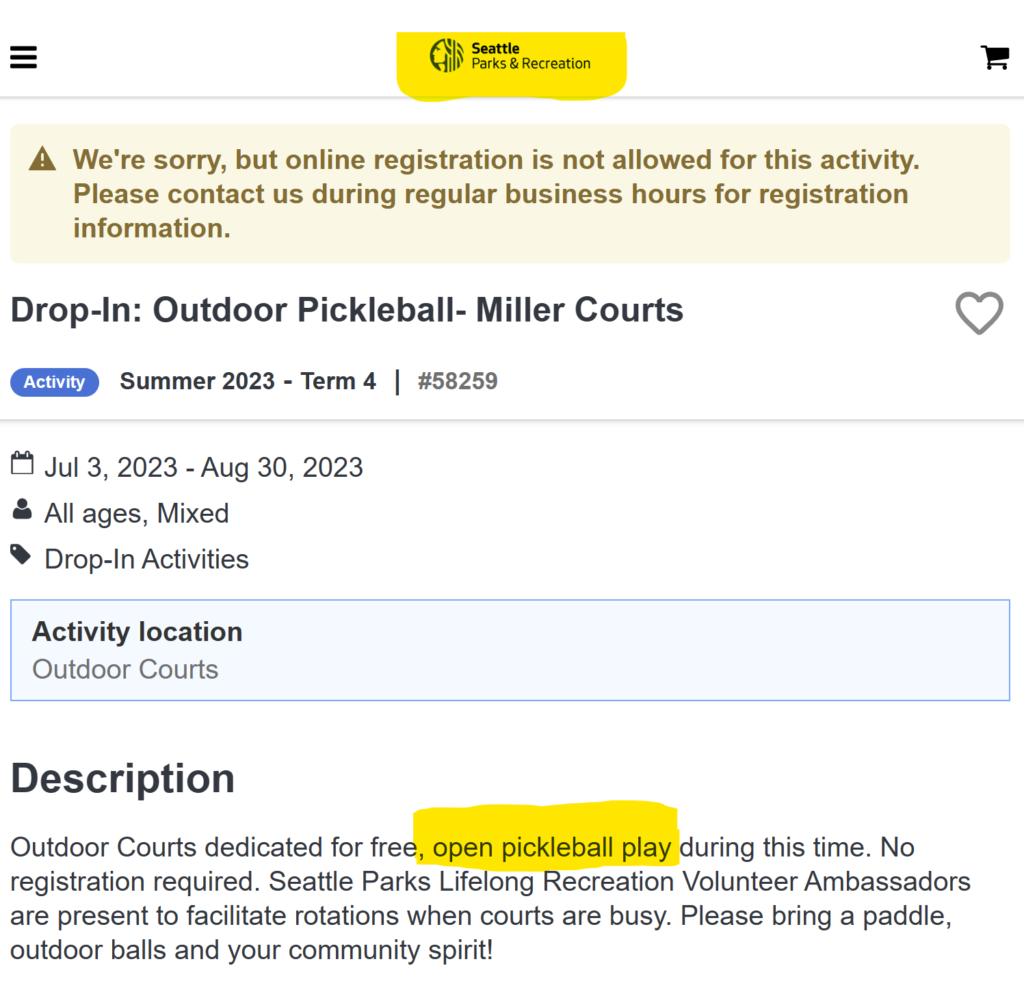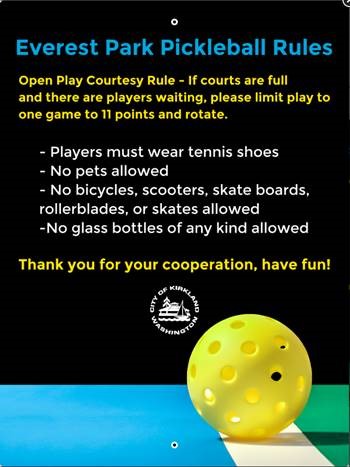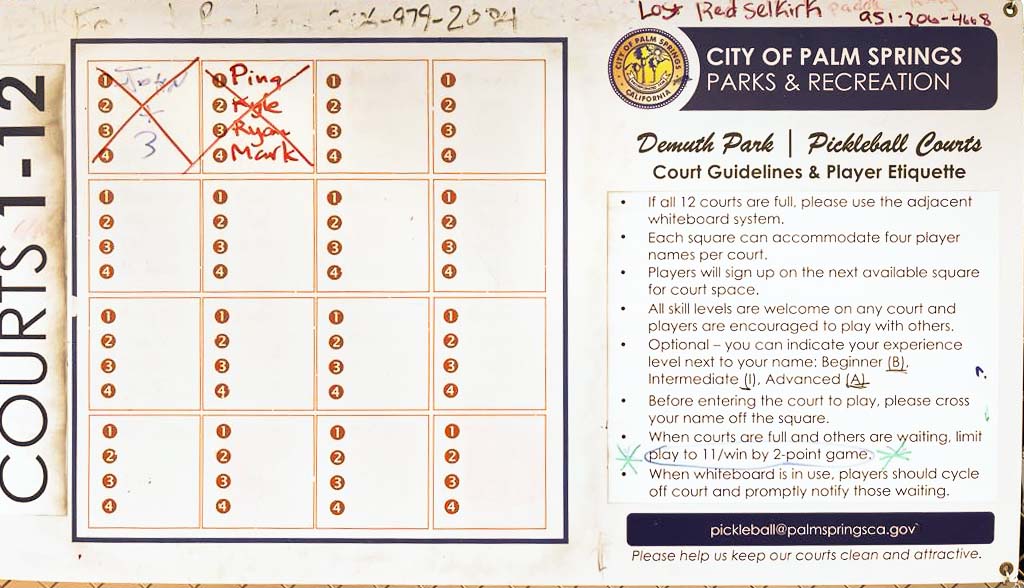TL;DR
Better Policies
Seattle Parks should implement open play policies at a few key pickleball locations throughout the city, such as Green Lake East in the north of the city, Miller Playfield in the center, Rainier Beach in the south, Solstice in West Seattle, as well as Magnolia Playfield.
Such open play policies would:
- prohibit all court reservations by individuals at these specific locations,
- prohibit all court reservations by instructors at these specific locations, and
- require players to limit play to one game to 11, then rotate when the courts are full and people are waiting to play, at these specific locations.
School and youth camp reservations for pickleball or tennis would still be allowed.
Players and instructors would still be able to reserve courts at other locations.
Open Play
What is Open Play?
Open play, which is also called drop-in play, is a system by which pickleball players share courts by rotating into games and playing with whoever else has also shown up.
A lot of public courts across the country require some form of open play at least when there are more players than the courts can accommodate.
Examples of Open Play Rules
Kirkland (WA)’s Parks Department asks that players rotate out after one game when the courts are full, and players are waiting.
Palm Springs‘ (CA) Parks Department offers an open play system that easily allows over 100 people to share 12 pickleball courts at Demuth Park.
The East Naples (FL) Community Park allows for open play on 59 pickleball courts simultaneously. Their web site says “Courts are not ‘reserved’ at our facility. Instead, we use a white board sign up process. You place your name on the white board with a dry-erase marker. It’s ‘Doubles’ Play. You play one game when it’s your turn and then leave the court and sign up again. You do not have to have a partner to join in a game. You can arrive by yourself and have plenty of people to play with.”
Open Play Accommodates Foursomes
Let’s say your family of four comes to the courts, expecting to play together as a family. Would those open play rules prevent you from playing together as a foursome? Not at all. At Demuth Park, you would put your four names together in an empty square. At Everest Park, where players line up stacks of four paddles, you would keep your family’s four paddles in the same stack.
Open Play Accommodates Lonesomes
Let’s say you come to visit Palm Springs with a dozen of your closest friends, but none of them are pickleball players. How will you ever get to play pickleball? Just drop by the courts at peak times, and you will be able to rotate in because Palm Springs has open play policies.
Open Play Accommodates Your Schedule
If you are joining open play, you do not need to get there at the beginning of the open play period: you can get there after play started and rotate in as other players rotate out. Similarly, you do not need to stay until the end of the open play period: you are free to leave after any game.
Open Play Is a Great Way to Allocate Limited Public Resources
Open play allows people to share a limited amount of courts in a practical and fair way.
Open Play Is Not the Solution to Court Shortages
Asking people to rotate in and out of courts only makes sense up to a point. While most everyone is willing to wait a few minutes for their next game, almost no one is willing to wait an hour to be able to play for fifteen minutes.
Open Play Requires Many Co-located Courts
This is a crucial point. In theory you can have open play on just one court. But to support a wide range of skill levels, you need to have many co-located courts available for open play. The more, the better.
Open Play Builds Community
Open play encourages people who have never met before to interact. Even if you choose to play exclusively with your own foursome, you will inevitably talk with other players while waiting for a court to become available.
Open Play Supports Diversity
Pickleball players come in all shapes and sizes. When you join other people for a game you might end up being a round peg joining forces with a square peg against pegs of unknown shape.
Open Play is Age Friendly
A good number of older Seattle residents find not only exercise but also social and intergenerational interactions through open play on the pickleball courts. If Age Friendly Seattle truly “supports learning, fitness, social, cultural, and spiritual activities for older adults as well as intergenerational activities that are accessible, affordable, safe, and fun“, then it should support open play pickleball.
“Most pickleball games use a rotation system, where you end up teaming up with and against strangers at almost every game. Players become fast friends, and use group chats and an app to co-ordinate games.”
Taylor Nicole Rogers, Pickleball is redefining retirement in the US, Financial Times, August 16, 2023
Open Play vs. Open Play
To be clear, there are various ways of implementing open play. We are not advocating for a specific implementation.
For the curious, here is one example of variations. One location with 12 or more pickleball courts could choose to divide them into three subsets according to skill levels (one each for beginner, intermediate and advanced players), and ask players in each subset to rotate. Another location with the same number of courts could choose to not divide them according to player skills and let the players manage skill matching by themselves.
Closed Play
What is Closed Play?
Closed play is the traditional way of organizing tennis play. Two or four people meet at the courts at a specific time where they will play together and then leave as a group.
How is Seattle Parks Favoring Closed Play?
At Seattle Parks pickleball courts, closed play is the law of the land. The whole outdoor court system is built around closed play. It was built for the tennis culture which expects people to get together in twosomes or foursomes to play at a specific location at a specific time.
If you want to be guaranteed a specific play time, you have to reserve a court. The courts that are not reserved (good luck finding out current reservation information online) are available on a first-come first-served basis for 60 to 90 minutes depending on whether you are playing as a twosome or foursome.
In this framework, how do you organize open play that involves multiple courts over multiple hours with many participants rotating in and out of play? The answer is: with great difficulty.

Why is Seattle Parks Favoring Closed Play?
Because all the courts are controlled by Seattle Parks’ Amy Yee Tennis Center and this organization has not yet embraced pickleball. It is also possible that it prefers maximizing the amount of money it collects through reservation fees over supporting community building and providing equitable access to the courts.
What Are the Consequences of Only Supporting Closed Play?
It leads to public reactions such as this one recently published in The Stranger newspaper: “Why does the City let people hoard public access to community fun and exercise? Do better, Seattle Parks!“ .
“Why does the City let people hoard public access to community fun and exercise? Do better, Seattle Parks! Not everyone has the time and the funds to access the reservation system and pay up.“
The Stranger, May 31, 2023
People participate in outdoor pickleball open play all over the country and are quite puzzled when they find that Seattle Parks favors closed play over open play.
Here is a remark from a Texan visiting the Green Lake courts this summer: “Reserving courts at prime playing times should be frowned upon. It is a public park and booking the courts to drill or do a lesson when you have people waiting on a shared resource is really a selfish act. […] I was tight lipped about how these PB guys were able to reserve these courts to drill or not share limited resources as well as tennis players able to book over pickleball with pb locals and visitors just waiting on the remaining available court space.”
“Where can I find the hours for open play at Miller in Seattle? Wondering if Saturday is open play?”
Post on the Seattle Pickleball Facebook group
It also leads to situations such as a father and his two tween sons waiting patiently to play on the Beacon Hill Playground pickleball courts one summer weekend, eventually giving up and leaving without playing, because two of the courts were in use by a group who had a three-hour reservation, and the two other courts were being used by pickleball foursomes that used the fullest extent of their “first-come first-served” privilege. Sure, the father and sons could have waited longer for one of the occupied courts to become available. Maybe they went looking for an unused pickleball court somewhere else. But wouldn’t the Seattle pickleball community at large have been best served if Seattle Parks had had a policy requiring open play when there are people waiting to play? Or if Seattle Parks had at least some locations where open play is required?
As the number of pickleball players keeps increasing dramatically from year to year, the resentment against Seattle Park’s current closed play policies keeps growing.
The Solution: Better Policies
Seattle Parks should immediately implement and widely announce open play policies at a few key pickleball locations throughout the city, such as Green Lake East in the North of the city, Miller Playfield in the center, Rainier Beach in the South, Solstice Park in West Seattle, as well as Magnolia Playfield.
Such open play policies would:
- prohibit all court reservations by individuals at these specific locations,
- prohibit all court reservations by instructors at these specific locations, and
- require players to limit play to one game to 11, then rotate when the courts are full and people are waiting to play, at these specific locations.
School and youth camp reservations for pickleball or tennis would still be allowed.
Players and instructors would still be able to reserve courts to their hearts’ content at other locations.
Community Reservations
Seattle Parks’ current court usage policies are built around a multi-tier reservation system. Here is how open play policies could be implemented in the current system.
Seattle Parks does not officially publish its current tier system, but its tiers are a variation on the following list, ordered by priority:
- public school reservations
- private school reservations
- youth camp reservations
- instructor reservations
- individual reservations
- first-come first-served
The open play policy proposed here would essentially introduce a new reservation tier, that we’ll call Community Reservations. Community Reservations would be inserted between trier 3 and 4 in the list above. These Community reservations would be initiated by Seattle Parks at specific locations and specific times. At the locations mentioned above, community reservations should be in force all day long, except when schools or camps want to use the courts. Other locations could have community reservations at specific times such as at peak usage times.
Nothing is New
It turns out that what is proposed here is not entirely new to Seattle Parks.
First, Seattle Parks requires open play for indoor pickleball in its community center gyms, so it is very familiar with the concept.
Second, Seattle Parks already hosts open play for outdoor pickleball at Miller, Delridge and Walt Hundley on some weekday mornings from 10am to noon. These outdoor open play sessions currently require the presence of “Volunteer Ambassadors”, but since other cities throughout the country manage to have outdoor open play without ambassadorships, why can’t Seattle do the same?

Since Seattle Parks is already requiring open play for indoor pickleball, and since it is already implementing some form of open play for outdoor pickleball, how hard could it be for it to extend open play to further outdoor times and locations? Actually, this will be extremely hard for Seattle Parks as long as it continues to treat all dual-use tennis-pickleball courts as primarily tennis courts on which people are occasionally allowed to play pickleball. At the moment, it looks like they are clinging on to the tennis closed play culture as tightly as they can and would rather be turned into pickles than make room for more open play.


